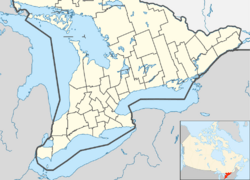Garden Island (Ontario) facts for kids

NASA image of Wolfe Island. Garden Island is the small island north of Wolfe Island directly beneath the mouth of the river labelled Kingston. New York is the landmass in the right corner.
|
|
|
Location in southern Ontario
|
|
| Geography | |
|---|---|
| Location | St. Lawrence River |
| Coordinates | 44°12′02″N 76°27′57″W / 44.20056°N 76.46583°W |
| Archipelago | Thousand Islands |
| Area | 30.75 ha (76.0 acres) |
| Administration | |
| Province | Ontario |
| County | Frontenac County |
| Township | Frontenac Islands |
Garden Island is a small island in Ontario, Canada. It's part of the Thousand Islands in the Saint Lawrence River. The island is about 3 kilometers (2 miles) south of Kingston. It covers an area of about 30.75 hectares (76 acres).
For many years, from the 1830s to around 1914, Garden Island was a very busy place. A family named Calvin ran a big shipping and lumber business there. They brought timber to the island, built huge rafts, and floated them down the Saint Lawrence River to Quebec City. From there, the timber was sent across the ocean to Britain. Today, Garden Island is much quieter, almost like a ghost town. Not many buildings from its busy past are left.
You can learn more about the island's history at the Marine Museum of the Great Lakes in Kingston.
Contents
How Garden Island Was Formed
Garden Island's land is similar to nearby Wolfe Island and Howe Island. All these islands are part of the Frontenac Islands area.
Ancient Rocks and Glaciers
The very old rocks under Garden Island are called metamorphic and igneous rocks. These rocks are part of a huge, ancient rock formation in Frontenac County. About 950 million years ago, these rocks were formed deep underground from old sediments and melted rock. Over millions of years, erosion slowly wore away the land above, revealing these ancient rocks.
Later, about 500 million years ago, a shallow ocean covered the area. This ocean left behind layers of sediment.
The last major ice age, called the Wisconsinian glacier, ended about 10,000 years ago. This giant glacier moved across North America, picking up rocks and soil. As it melted, it dropped all this material, creating the land we see today on Garden Island. The heavy ice also pushed the land down, allowing the Atlantic Ocean to flow in and create a large body of water called the Champlain Sea.
A Busy Island: The Calvin Era
In 1844, an American businessman named Delino Dexter Calvin started renting space on Garden Island. He chose the island because it had a safe bay. This bay was perfect for building huge timber rafts and for getting them ready to float down the river. Being in British Canada also made it easier for Calvin to ship timber to Britain. His company even had offices in Liverpool and Glasgow to handle the shipments.
The timber was tied together into large sections called "drams." These drams could be joined to make rafts as long as half a mile! In the early days, workers, often French-Canadians, used sails or long oars called "sweeps" to guide these massive rafts. The journey down the St. Lawrence River to Quebec could take over a month! Later, tugboats helped guide the rafts.
Building Big Ships
To keep his workers busy and make more money, Calvin also started a successful shipbuilding business on Garden Island. In 1836, they built their first ship for the timber trade, a 140-ton vessel named Queen Victoria. The next year, they built two more ships of the same size.
Life on Garden Island: A Company Town
In 1862, Calvin's company bought the entire island. To support their operations, a small community grew on Garden Island. About 750 people lived there, mostly workers and their families. The island even had three streets: Broadway, Fancy Street, and Blanchette Avenue. The company built houses and rented them to the workers.
As the community grew, so did its needs. Garden Island had its own butcher, baker, and a general store. They even had a dairy farm on the island! By 1867, telegraph wires connected the island, and in 1890, the telephone arrived.
Calvin cared about his employees. He helped pay for a school, a library, and a post office. The library was called a "Mechanics Institute" and had over 6,000 books, thanks to a gift from Andrew Carnegie. The island was so self-sufficient that it even used its own special money!
During a tough economic time in 1873, Calvin chose to lower wages instead of firing workers. This helped everyone keep their jobs. The island also followed Calvin's personal beliefs and did not allow alcohol.
As timber became harder to find in the Great Lakes area, Calvin's business slowly declined. By 1921, only four people lived on Garden Island. The island was no longer considered a "village" and became part of the Township of Wolfe Island.
Today, Garden Island is still owned by Calvin's descendants, who use it as a summer getaway. A ferry used to go to Garden Island from Wolfe Island, but that service stopped in 1976.


